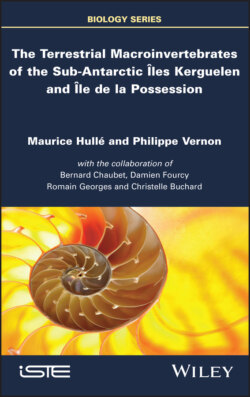Читать книгу The Terrestrial Macroinvertebrates of the Sub-Antarctic Iles Kerguelen and Ile de la Possession - Maurice Hulle - Страница 10
Оглавление
Foreword 2
When confronted with a book about invertebrates of sub-Antarctic islands, we might expect a boring list written in a 19th-Century fashion by museum experts about their identification… But the multidisciplinary state of the art of two modern field naturalists makes this book fascinating. Maurice Hullé and Philippe Vernon have indeed been remarkably successful in providing a story on biodiversity, with nice iconography, which started in 1830 and is still evolving today.
It is also nice that this book provides a historical view, a well-deserved tribute to those pioneers who first described the remarkable endemic larger invertebrates of the sub-Antarctic Îles Kerguelen and the Île de la Possession (Eaton, Waterhouse, Jeannel, Dreux, Voisin, etc.) and on their expeditions (Challenger, Volage, Gauss, etc.). It was indeed the time of the first discovery and description of species. And also the time when similarities of these invertebrates were found with the remote wildlife of Africa and America. It raised puzzling questions on the way the invertebrates were once established on the islands.
But in the 1970s and 1980s, there was a huge academic pressure on biologists worldwide to abandon such projects, obviously involving the collection of long-time series, for a more mechanistic approach in cellular and molecular biology. As a result, systematicians and field biologists disappeared from universities and research organizations. Physiology, once predominant when molecular biology emerged, became a science of the past. However, as a pocket of resistance, long-term programs on biodiversity received logistics and funding by the successive French organizations in charge of sub-Antarctic research (Mission de Recherche des Terres Australes et Antarctiques Françaises (TAAF)1, Institut Français de la Recherche et de la Technologie (IFRTP)2 and Institut Polaire Paul-Émile Victor3 (IPEV)). Thanks to the principal researchers, Paul Tréhen and Yves Frenot, and thanks to the support of the Centre National de la Recherche Scientifique (CNRS), particularly in the recruitment of new scientists, long-term series were obtained.
Technicians and engineers also played a major role in the treatment of field data and samples. It is not surprising that some of them contributed largely to the preparation of this book. In particular, the engineer Romain Georges and the technicians Christelle Buchard and Bernard Chaubet should be acknowledged. Thanks to them and to all the volunteers who, over the years, have been overwintering in Kerguelen and the Île de la Possession. Our knowledge on the biology of the larger invertebrates of Kerguelen and the Île de la Possession has considerably increased over the last decades, as shown in this book.
The focus was particularly on their geographical distribution, their ecology and population dynamics. We note that it is also then that it was perceived that the endemic fauna of the islands was not in a preserved sanctuary but had to cope with an increasing number of introduced species. Meteorological recordings made it possible to characterize the first changes in ambient temperature and rainfall, indicating climate changes. They also showed that even a small increase in ambient temperature and drop in rainfall could facilitate the influx of invasive species.
With such knowledge being securely documented by field work and long-term series, this book illustrates how powerful it is to now enter a mechanistic and functional approach. Ecophysiology is the key to determining the environmental conditions which enable or limit the ability of invertebrate newcomers to survive and establish themselves on the islands and for the endemic species to deal with such invaders. Complementing the understanding of physiological mechanisms of adaptation, genomics open new perspectives to decipher and understand the origin and biogeography of sub-Antarctic invertebrate fauna.
Thus, altogether, this book is not only about the listing of the larger invertebrates of Kerguelen and the Île de la Possession. It is a truly remarkable story on a field and laboratory research which is still ongoing, providing detailed information on the origin, evolution and ecosystem functioning of the invertebrate fauna of sub-Antarctic islands.
Yvon LE MAHO
Emeretus Director of Research, CNRS, Institut Pluridisciplinaire Hubert Curien
(University of Strasbourg/CNRS) and Centre Scientifique de Monaco
Member, French Academy of Sciences and Chair of the board, French Polar Institute
Strasbourg, France
September 2020
1 1 Research mission of the The French Southern and Antarctic Lands.
2 2 French Institute of Science and Technology.
3 3 The French Polar Institute Paul-Émile Victor.
